Introduction
On a sample of sixty seeds of three plant organisms, Glycine max, Capsicum annuum Group, and Brassica oleracea var. Italica, the effect of soil salinity on seedling growth was measured in parallel. For this purpose, water with different sodium chloride concentrations was used: 3, 6, 9, and 12 ppt. Seed samples were grown under different salinity conditions. It is expected that higher salt concentration may not be suitable for growth.
Hypothesis
High values of salt concentration inhibit the growth and development of seedlings, while medium values, on the contrary, stimulate the germination of all types of seeds. First of all, this effect can be justified by the selected plants’ physiological properties. Not being halophytes, broccoli, bell peppers, and soybeans are difficult to survive an increase in soil salinity. The accumulation of even harmless salts increases the soil solution’s osmotic pressure and often leads the environment to physiological dryness and consequently makes water supply to the plants difficult. In this case, such a phenomenon can be observed where even with sufficient soil moisture, the plant cannot supply itself with water thoroughly.
Background
Biological soil quality and plants’ ability to demonstrate adaptability and resilience to depressing factors are essential components of future food issues. According to statistical projections, the global population will reach the 10 billion mark by 2050, and that number will continue to grow (Lapenis). Without emphasizing the economic and biological threats of such a phenomenon, it is worth recognizing that feeding each member of society will be a significant problem for countries. If the agricultural industry cannot be optimized, countries with the largest populations will experience a starvation crisis, which may be predictor of conflict. To avoid such a scenario, it is appropriate to investigate plant resilience as profoundly as possible today.
Moreover, overpopulation is related to the intensification of global climate warming, which also has relevance in the context of the topic under study. Over the next hundred years, the average annual temperature will continue to rise. It follows that additional water resources will evaporate more actively from regions with fewer rainfalls, which means less water will remain for plant nutrition. In other words, salt concentrations in soils will continue to increase naturally, which may cause most plants to die.
It is worth recognizing that soil salinity is an essential predictor of possible plant suppression. Already today, 23 percent of arable land is found to be excessively saline (Shahid et al. 46). Simultaneously, this number was three percent lower in the 1990s, which may confirm trends toward increasing salinity in irrigated lands (Shahid et al. 46). Although control is necessary, it is also essential to take early care of the biological properties of the crops grown and possibly take preventive measures to modify the plants to improve their resistance.
Special attention within the framework of the discussed issue is drawn to the soil features of the United Arab Emirates. It is primarily worth recognizing that this state is a progressively developing economic center not only in Middle Asia but probably in the whole of Eurasia. The country is actively expanding, and although the basis of its economy is the sale and processing of oil and oil products, combined with the development of the tourism sector, agriculture plays an important role. As a de facto amalgamation of seven emirates, the UAE, with a combined population of approximately ten million, must meet residents’ fundamental needs for sufficient food resources (United Arab Emirates Population).
The variety of crops grown and the need for agricultural measures for soil moisture and irrigation depend on the arable land belonging to a particular category (Wiede). It is worth saying that there are many different types of soils in the UAE. Thus, Torripsamments, wind-borne alluvial sands well suited for farming (UAE Soil Maps) form the basis or about 75%. Nevertheless, about 10% of the total soils are set aside for highly saline and mineral-rich carbonate zones, where plant survival is a problem. Even though groundwater is present at a depth of about one meter, these soils are still arid and biologically unsuitable. Thus, UAE authorities can expect that such soils can only increase over time.
The choice of specific crops was based primarily on their widespread availability as a food commodity. For example, soybeans are is an excellent high-calorie product rich in protein. In addition, Glycine max can also be used as a source for the production of biofuels (Szecsei). In other words, the popularity of soybeans for consumption is incredibly high, which justifies the increase in cultivated areas for this crop (Figure 1). Similar figures are found for broccoli and bell peppers: the consumption of broccoli has increased by 940% over the last 25 years and by 150% for bell peppers over the last twenty years in the U.S. (Mullaney; Shahbanden). In other words, the selected crops are precious to humanity, which means their conservation and increased sustainability indices are a positive ecological strategy.
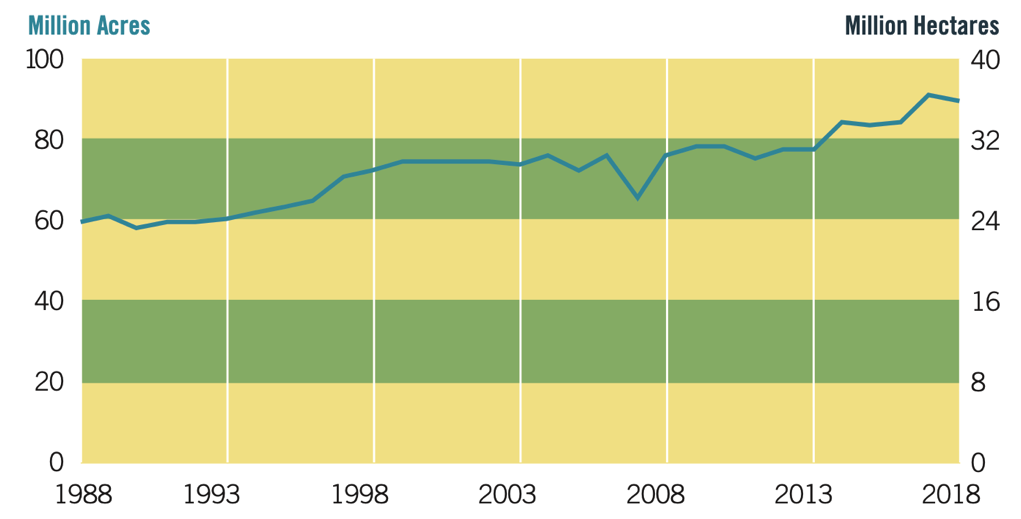
In addition, the plants proposed for the experiment are not halophytic, and therefore are very sensitive to salt fluctuations in the soil. The consequences of inhibition of plant growth associated with high salt concentration are due to biological effects. In particular, excess salt in the pre-root zone can increase the osmotic pressure, resulting in water flowing from the roots back into the soil. As a result, dehydration of plants and their drying is observed. In addition, if sodium chloride is used as the central salting compound, as in this study, it can lead to unwanted dissociation to form chlorine ions. Being toxic, chlorine ions poison plants and catalyze death processes. Simultaneously, as a more active metal, sodium can replace calcium, iron, and magnesium, which are vital to plant metabolism (Impacts), from mineral compounds. Ultimately, this salinity leads to lower yields and a drop in crop profitability.
Variables
The concentration of salts in the soil samples was modified to measure crop growth rates. Thus, the concentration of sodium chloride in the soil for sprouting was an independent variable and numerically represented a range of four different concentrations: 3, 6, 9, and 12 ppt. In addition, a water-only control line was used. The technique for preparing the specific solutions is described in detail in the methods section. The seeds were covered with dark thick towels and the room temperature was kept constant, so these parameters did not contribute. The effect of concentrations was measured using dependent variables, namely the germination rate (in days), the number of germinated seeds, and several mathematical measures.
Materials
- For germination process:
- Ziplock plastic bags;
- Thick tissue paper;
- Plastic disposable plates;
- Marker;
- Spray bottle;
- Saline solutions with concentrations of 3. 6. 9 or 12 ppt;
- Glycine max 60 pcs;
- Capsicum annuum Group 60 pcs;
- Brassica oleracea var. Italica 60 pcs.
- For seedling process:
- Soil mixed with fertilizer;
- Plastic pots with holes at the bottom;
- Watering container.
- For both processes:
- Scale;
- Flaked sea salt;
- Paper and pen;
- Measuring tape;
- Thermometer — 20°C to 120°C
Method
This biological experiment was designed as a series of sequential tasks performed according to laboratory ethics and safety guidelines. Seeds of plants of three different crops, sixty seeds each, were obtained from a local horticultural center. They were thoroughly sanitized before germination to eliminate possible infestations using hydrogen peroxide, apple cider vinegar, and distilled water. The seeds were placed between two strips of wet paper and packed in a plastic bag to ensure continuous moisture content. The seeds were placed in a dark area and covered with a thick towel to prevent light penetration. After the seeds germinated under the sealed plastic bag’s conditions, 5 to 10 seeds were transferred to pots under natural light at 21°C to 23°C. Additional water was added to each pot in the morning using a spray bottle.
The choice of specific salt solution concentrations was determined by the results of a preliminary experiment (for 10,25,40 and 55 ppt), showing that the highest optimal salt content for growth was ten ppt. Thus, four solutions with four different concentrations were prepared in parallel: 3, 6, 9, and 12 ppt. Preparation of the solution began with weighing the necessary mass of sodium chloride in the form of flakes on a scale: for the three ppt solution, the mass was 3 g. After filling the sample gallon with salt flakes, distilled water was added to the 1000 g mark. The solution was thoroughly stirred to dissolve the sea salt completely. The same procedure was repeated for concentrations of 6, 9, and 12 ppt.
Seed germination was considered when the shell was destroyed, and the first roots became apparent. For accurate analysis, seed control was performed every day in the morning for each sample. Seeds infected with the fungus were disinfected with vinegar solutions or removed if sanitization was not possible. The following mathematical formulas were used to measure seed germination rate and efficiency.
Table 1. Formulas are used to measure seed germination rate (Kader 68; Gairola et al. 67; Germination Rates & Percentages).
Data
Table 2. Summary table of calculated values for all samples. The calculations are shown in equations [9]-[14].
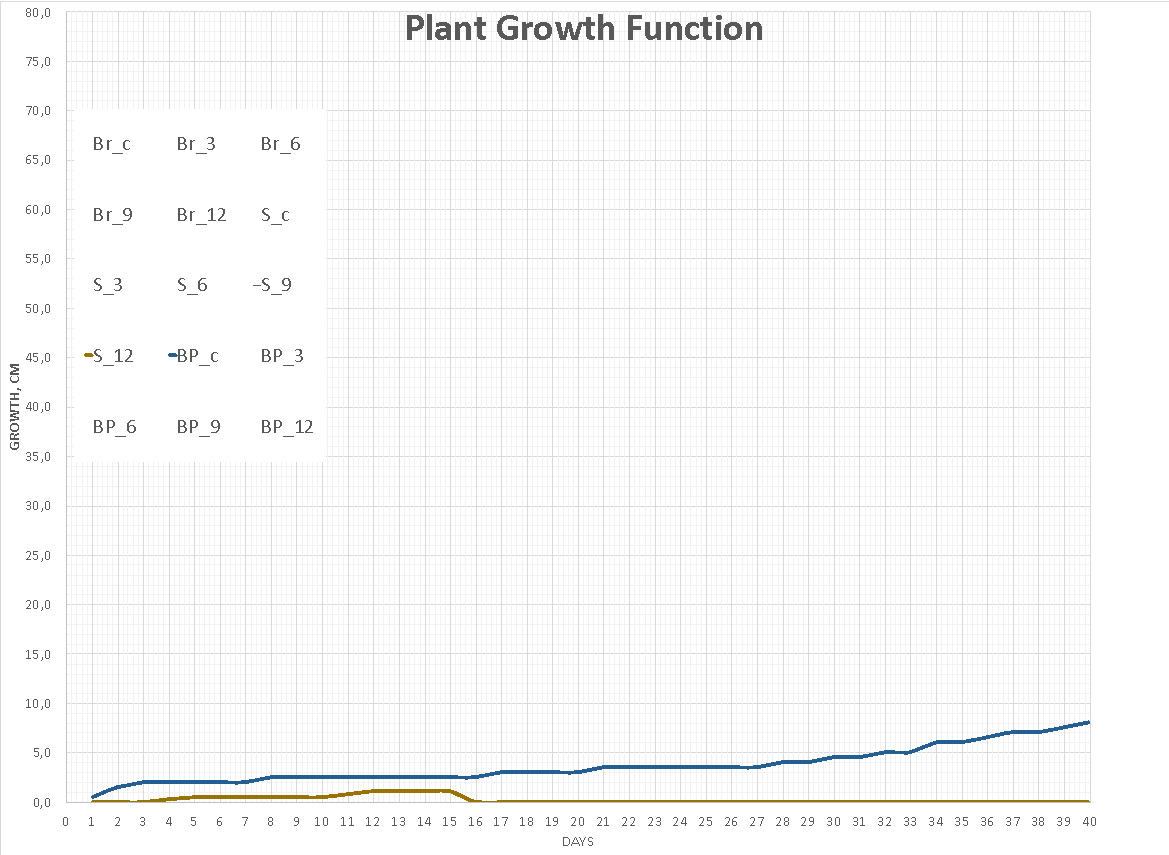
Data analysis
As can be seen, when analyzing Table 2, some of the crops did show excellent growth results under certain salt concentration conditions compared to others. In particular, for broccoli and soybeans, soil with a salt content of 3 ppt was the most optimal medium. Bell peppers showed the best growth performance in the control sample, but 3 ppt again showed the best results when evaluating experimental data alone. It may follow from this that the minimum salt content of the soil stimulates the growth and development of different crop plants. In contrast, increased content led to premature death or failure to mature.
Figure 2 shows a composite growth chart for all fifteen lines examined. Some of the lines dropped drastically to zero in the first half of the trial: this indicated that the plant had stopped showing growth and had suffered salt injuries. On detailed analysis, this was confirmed: indeed, the zeroed-out lines corresponded to high salt concentrations. Thus, one can conclude that the higher the salt concentration, the more likely the no germination.
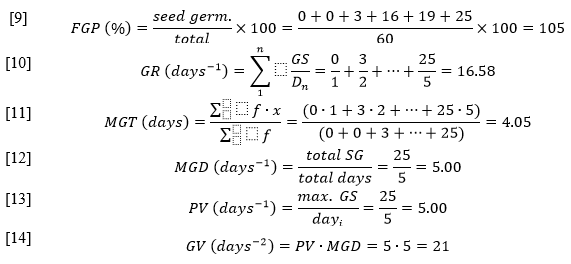
Several intriguing patterns have been observed. First of all, Table 3 shows that salinity at 3 ppt is indeed optimal for all sample types even when compared to control lines. Statistical analysis using the standard deviation model indicates the mean deviation and error of the established mean values. The 12 ppt value suppressed seed germination the most and averaged the lowest mark of 45% germination. On the other hand, as Table 4 shows, the control line and the three ppt salinity were similar in seed germination rate. In contrast, the seeds of the bell pepper sample sprouted most recently at 12 ppt. Table 5 demonstrates the effect of concentration on average plant growth: the higher the salt level, the lower the plant height was.
Table 3. Statistical information on the number of germinated seeds in all measurement groups.
Table 4. Statistical information on the speed of seed germination in all measurement groups.
Table 5. Average values of plant height (cm) depending on salt concentration.
Graphs
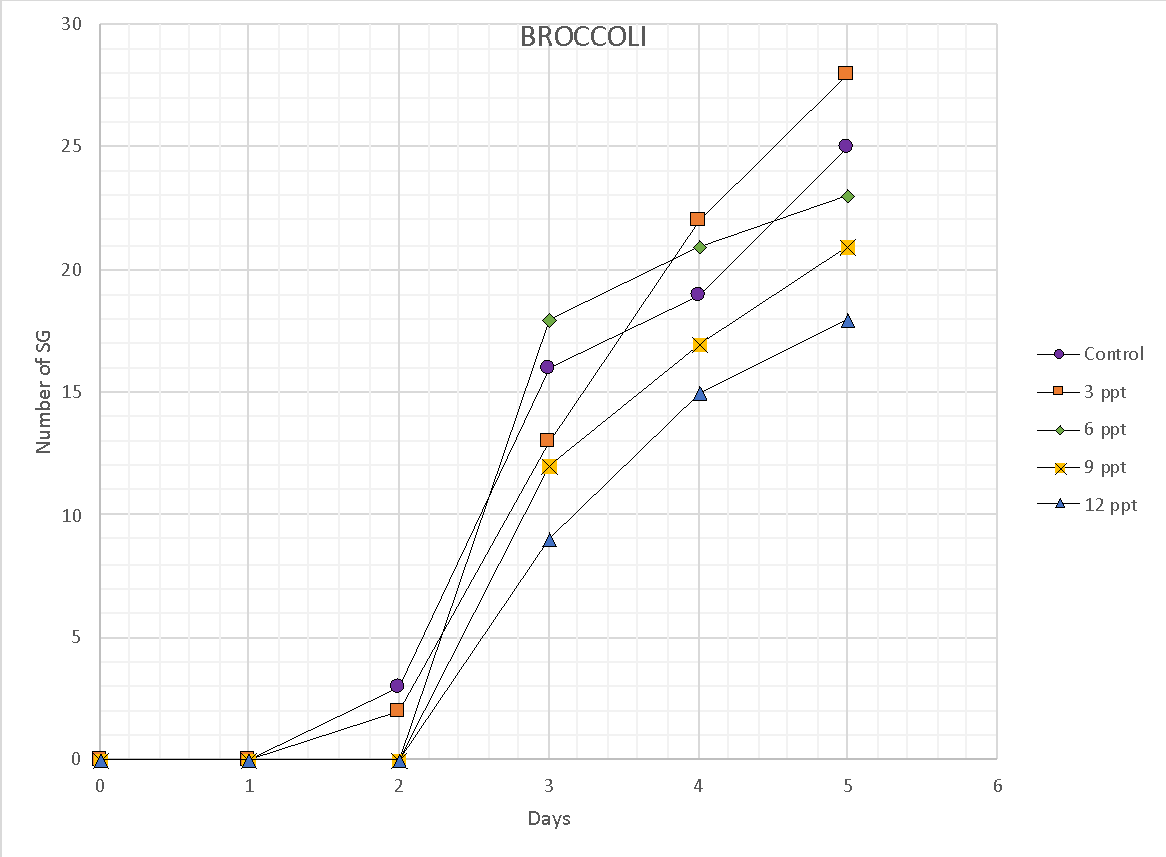
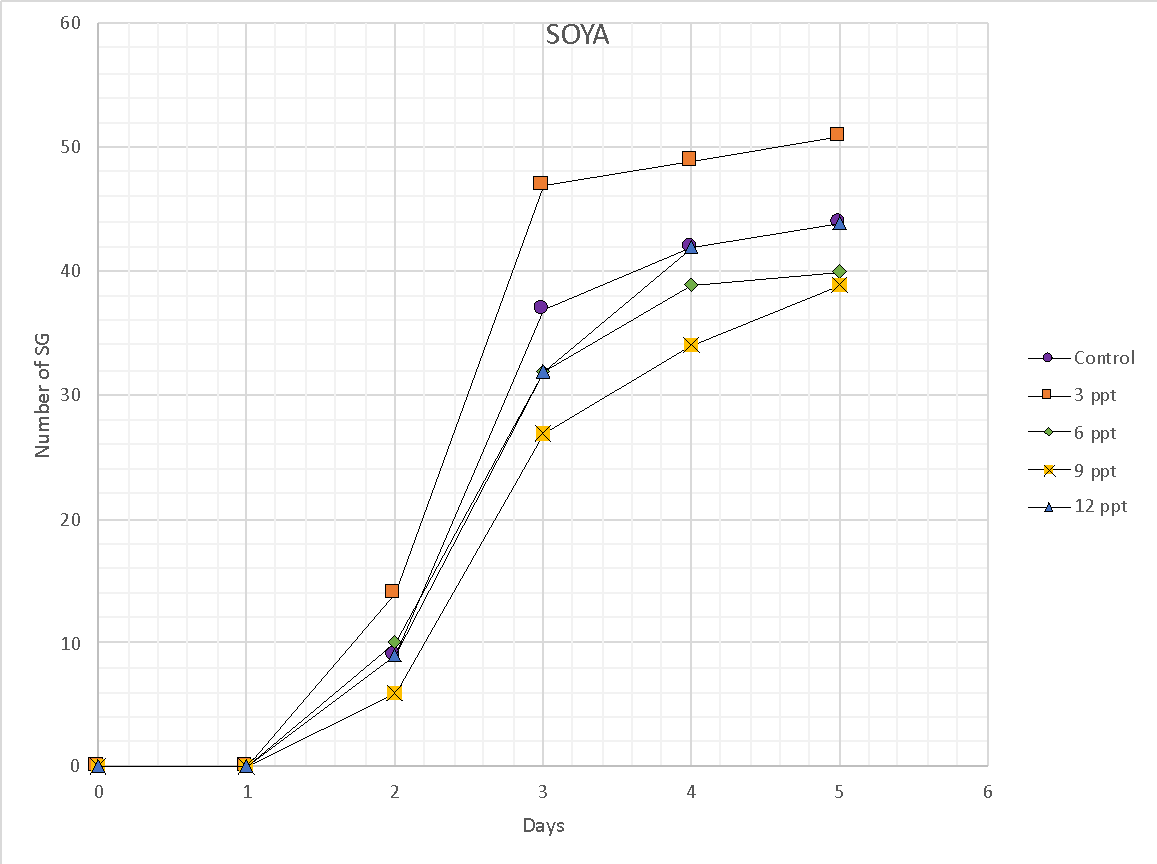
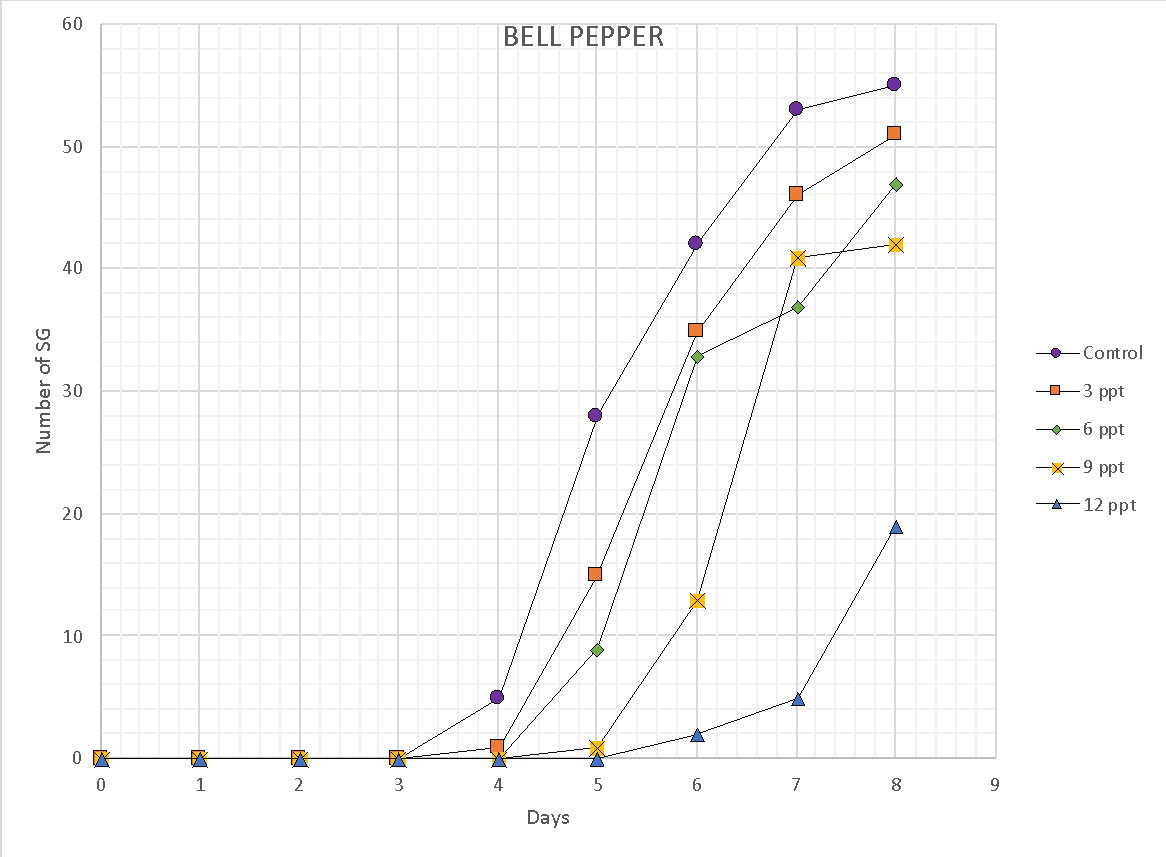
Conclusion
To summarize the study results, it is worth noting that soil salinity does have a significant effect on the growth and development of the three plant crops. The report confirmed the original hypothesis that a gradual increase in salt concentration in the soil naturally reduces the seed germination rate and plant height. The best results were characteristic of the control line devoid of excess salt and the lower salt concentration. On the other hand, the higher the soil salinity, the fewer plant seeds germinated.
Works Cited
ASA. “2019 Soystats.” Soy growers. 2019. Web.
Gairola, K. C., A. R. Nautiyal, and A. K. Dwivedi. “Effect of Temperatures and Germination Media on Seed Germination of Jatropha curcas Linn.” Advances in Bioresearch, vol. 2, no. 2, 2011, pp. 66-71.
“Impacts of Salinity.” Queensland Government. 2016. Web.
Kader, M. A. “A Comparison of Seed Germination Calculation Formulae and The Associated Interpretation of Resulting Data.” Journal and Proceeding of the Royal Society of New South Wales, vol. 138, 2005, pp. 65-75.
Lapins, Andrei. “A 50-Year-Old Global Warming Forecast That Still Holds Up.” EOS. 2020. Web.
Mullaney, Sara. “Broccoli.” Food Source Information. 2020. Web.
Shahbandeh, Mahsa. “U.S. Per Capita Consumption of Fresh Bell Peppers 2000-2019.” Statista. 2020. Web.
Shahid, S. A., Zaman, M., & Heng, L. “Soil Salinity: Historical Perspectives and a World Overview of the Problem.” Guideline for salinity assessment, mitigation and adaptation using nuclear and related techniques, edited by Mohammad Zaman, Shabbir Shahid, and Lee Heng, 2018, pp. 43-53.
Szecsei, Szabolcs. “26 Delicious Soy Statistics to Chew On in 2020.” Supplements 101. 2020. Web.
“UAE Soil Maps.” Emirates Soil Museum, n.d. Web.
“United Arab Emirates Population.” Wordometer. 2021. Web.
Wiede, Jochen. “Saline Soils: A Landscaping Challenge.” CSBE, 2005. Web.
“Germination Rates & Percentages.” Plant Psychology, n.d. Web.







